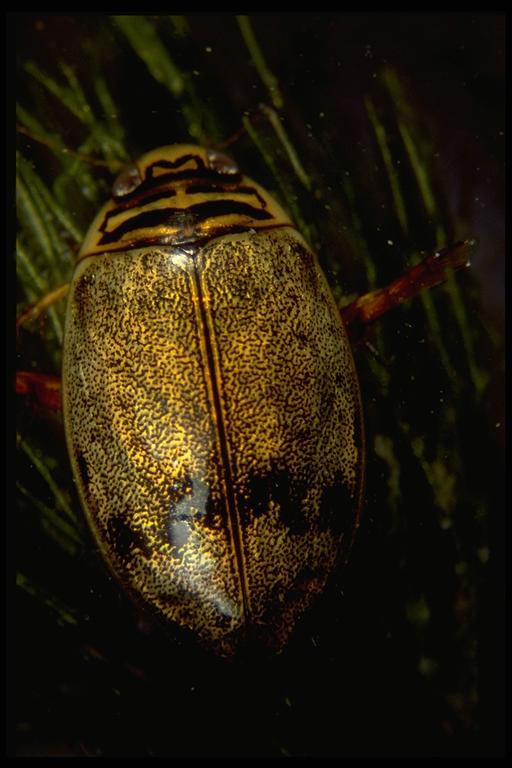
A diving beetle, Thermonectus sp. (Coleoptera: Dytiscidae). Photo by Drees.
Common Name: Diving beetle
Scientific Name: Thermonectus sp.
Order: Coleoptera
Description: Adult beetles have streamlined, oval or football shaped flattened bodies that are usually 1/8 to 1 inch (3 to 25 mm) long. Most species are brown to black but some have distinctive patterns of spots, lines or mottling on the wing covers (elytra). They have elongate hairlike (filiform) antennae. Larvae are not frequently seen and have a long thorax and long legs. The head bears conspicuous large sickle-shaped mandibles without teeth.
Predaceous diving beetles are easily confused with water scavenger beetles (Coleoptera: Hydrophilidae). The latter surface for air head first and have a ridge or keel on the underside that runs down the thorax and extends into a point.
Life Cycle: Adults and larvae are found in water. Larval development time is not known for many species in this large family. Some species that inhabit vernal ponds develop into adults in a few months.
Habitat and Food Source(s): Mouthparts are for chewing. These predaceous insects feed on a variety of aquatic organisms, including small fish. These beetles may be found in nearly any body of water. They fly into small ponds and puddles and can even be found in saline ponds. Adults frequently surface for air, holding the tip of the abdomen to the surface to obtain air which is stored under the wing covers (elytra) to breath. They are good swimmers and use their legs in unison to propel themselves in a straight line in a jerky fashion. Males of some species have an enlarged portion on the front leg that is used as a suction disc to hold the female while mating.
Pest Status: Beneficial insect; predaceous on other insects; immature stages (larvae) sometimes called “water tigers”; capable of biting, but generally medically harmless. When numerous in fish hatcheries, they may reduce numbers of fry.
Management: None, this is a beneficial insect.
For additional information, contact your local Texas AgriLife Extension agent or search for other state Extension offices.
Literature: McCafferty 1981.